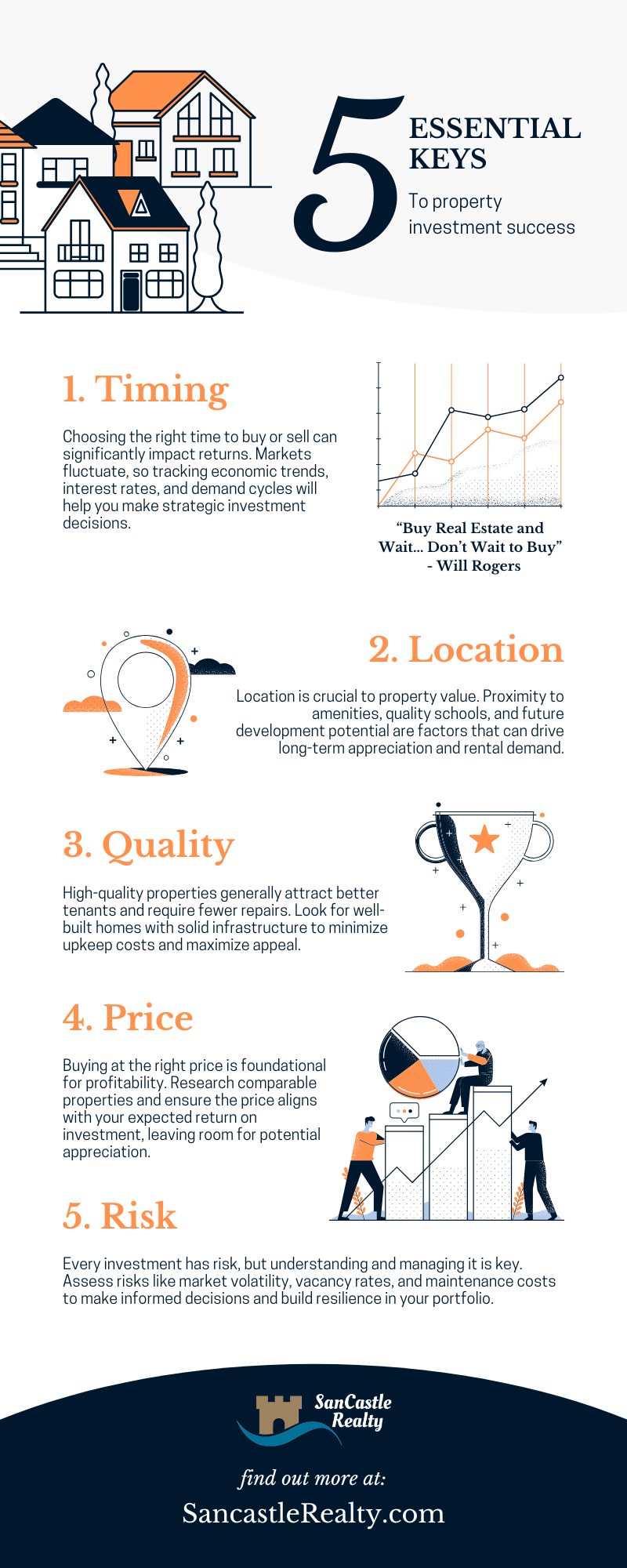
5 Essential Keys to Success in Property Investment: Timing, Location, Quality, Price, and Risk
Introduction
Property investment remains one of the most reliable paths to building wealth, but success requires more than just a lucky purchase. From understanding market timing to assessing risk, each decision impacts potential returns and overall financial security. In this guide, we’ll walk through the 5 key points to property investment success: Timing, Location, Quality, Price, and Risk. Whether you’re an experienced investor or just starting, mastering these elements can elevate your investment strategy and maximize your profits.

1. Timing: When You Buy Matters
Timing is crucial in real estate investment. Property values often rise with market cycles, and purchasing at the right moment can increase the potential for rapid equity growth.
Market Cycles: Real estate markets typically move through phases: expansion, peak, contraction, and recovery. Buying during a market contraction or early recovery can provide a solid entry point with lower prices and increased growth potential.
Interest Rates: Interest rates directly affect financing costs and investor cash flow. Lower rates, like those seen in 2020 and 2021, make borrowing cheaper and often lead to an increase in property demand, which can be advantageous.
Seasonal Trends: Research shows that spring and summer typically see higher transaction volumes and prices. Meanwhile, fall and winter offer fewer buyers, which may create room for better negotiations.
FAQ: How can I time the market if I'm new to property investment?
Consider working with a real estate agent or investment consultant who has insight into local trends, and stay informed by tracking housing market reports, mortgage rate trends, and regional news.
2. Location: The Power of Where You Invest
In real estate, location is a long-standing cornerstone of investment success. Even if you purchase at the right time, a poor location can hinder your investment’s growth and rental potential.
Growth Potential: Look for cities or neighborhoods experiencing growth in population, infrastructure, or job opportunities. Areas near new business developments, top-rated schools, or public transport tend to see long-term appreciation.
Amenities and Lifestyle Appeal: Proximity to amenities like shopping centers, hospitals, and recreational areas can make properties more attractive to renters and buyers. Homes in walkable neighborhoods tend to have a premium in urban areas.
Safety and School Districts: For family-oriented buyers or renters, safety and school quality often drive decisions. Properties in low-crime areas with reputable schools can attract stable, long-term renters or buyers willing to pay higher premiums.
FAQ: What’s the most reliable way to evaluate a location?
Conduct a market analysis using local real estate data, consult local agents, and check neighborhood quality metrics on websites like NeighborhoodScout or Walk Score for comprehensive insight.
3. Quality: The Impact of Property Condition and Construction
Investing in high-quality properties can save on repair costs, attract premium tenants, and reduce vacancies. Quality matters both for the property itself and the neighborhood as a whole.
Construction Standards: Properties with strong construction quality can withstand adverse weather and reduce maintenance expenses over time. Look for homes built with durable materials and updated infrastructures, such as plumbing and wiring.
Curb Appeal and Interior Finishes: Attractive, well-maintained properties draw in higher-quality tenants or buyers. Landscaping, modern appliances, and appealing design features can boost demand and allow for a higher rental rate.
Energy Efficiency: As utility costs rise, energy-efficient features—like insulated windows and energy-efficient appliances—add value. Energy Star-rated properties or homes with solar panels often command higher rent and resale values.
FAQ: Should I buy a fixer-upper or a move-in-ready property?
Fixer-uppers can be profitable if renovation costs are manageable and the property is in a desirable location. However, move-in-ready properties tend to attract tenants faster and may be less risky for new investors.
4. Price: Setting Up for Profitability from the Start
Buying a property at the right price ensures that you’re setting yourself up for profitability. Pay close attention to property valuations and comparable market prices.
Market Comparables (Comps): When evaluating price, look at recent sales of similar properties nearby. Comps provide a snapshot of the fair market value, helping you avoid overpaying.
Profit Margin Goals: Define your investment goals in advance. For example, if you're investing for rental income, calculate the expected ROI to ensure it aligns with your targets. The “1% rule” suggests that monthly rental income should be at least 1% of the property price.
Negotiation and Closing Costs: Don’t overlook closing costs like title fees, inspections, and agent commissions. These can add up, so it’s important to account for them when determining if the price fits your budget.
FAQ: How do I know if a property is fairly priced?
Use online tools like Zillow’s Zestimate or Redfin’s Estimate as a starting point, but consult a real estate agent for a more accurate price analysis based on recent local sales.
5. Risk: Knowing and Managing Investment Risks
Every investment comes with some degree of risk. Identifying potential risks and planning accordingly can help protect your capital and stabilize returns.
Market Volatility: Economic factors like inflation, unemployment, and interest rates affect property values. A solid investment plan accounts for potential market fluctuations.
Vacancy Risks: High vacancy rates in certain areas can lead to lost income and increase maintenance costs. Look for high-demand areas with low rental vacancy rates or invest in properties close to universities or business centers, where demand is stable.
Insurance and Liability: Protecting your property investment with adequate insurance is essential. Coverage for natural disasters, loss of rental income, and liability can mitigate the financial impact of unforeseen events.
FAQ: What’s a good way to minimize risk as a new investor?
Start with lower-risk property types, such as single-family homes in stable neighborhoods, and gradually diversify as your experience grows. Work with professionals to evaluate market conditions and ensure your risk exposure matches your comfort level.
Conclusion
Success in property investment boils down to strategic decision-making in five areas: Timing, Location, Quality, Price, and Risk. By understanding and balancing these key factors, you’ll be better positioned to make profitable investments that align with your goals. Whether you’re seeking consistent rental income, property appreciation, or a balanced mix, these five elements provide a solid foundation for success. Take the time to research, plan, and act confidently in your property investment journey!
For expert guidance tailored to your goals, connect with John and Brenda Sansaricq at Sancastle Realty. With their in-depth knowledge of the market, they’re here to help you make smart, informed decisions. Contact Sancastle Realty today to start your property investment journey!
